Catamarans and Waves
As I have noted before, the accident last November involving that poorly designed and narrow catamaran turned over by a wave seems to have now involved us all as multihull designers.
I was ordered, as I assume all other cat designers were, to create extensive static hydrostatic data at every possible and even impossible state of immersion. I even had to subcontract out GHS studies that could not be done with Prolines. Not one bit of the data shed any light on catamaran stability in waves. As my friend and naval architecture wunderkind Eric Sponberg wrote to me “I agree with you that running extensive hydrostatics doesn’t tell anyone anything” as to why a catamaran rolled over.
But the Coast Guard could and did order me to do that with the same tone of voice that the State Patrol uses when they order you out of the car.
I have heard it said that when a bureaucracy has no tools to deal with a crisis, they will rely on a blizzard of data. I seem to be seeing that.
I would have thought that they would have asked me or Roger or anyone else who has done a few dozen USCG certified cat designs what we thought. Not a word. Instead it was guns drawn and “you will comply”.
Eric recommended “For a better understanding of capsizing, the USCG should refer to C.A. Marchaj’s book “Seaworthiness–The Forgotten Factor”. It at least discusses the nature of capsizing, including catamarans.” I’m sure it was not done.
Actually there is a body of work that applied directly to this incident. Back in the ‘90s when I was in Tasmania, I had discussions with the late Lock Crowther on this very topic. He is the only one I know of who had done extensive tank testing on catamarans in large beam-on waves. The following is what I recall. I think it was published in Multihulls, but I have no idea what issue.
He explained that as the wave hits the first hull, that hull is of course flipped up in the air.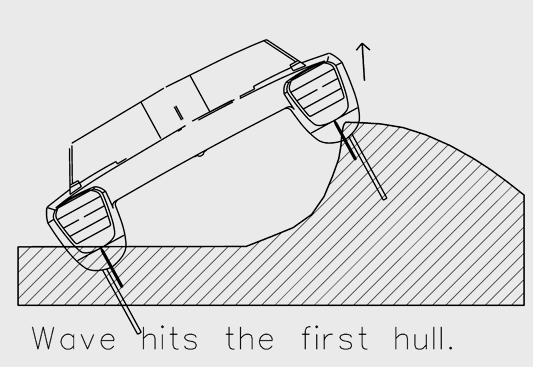
Then the wave charges along toward the next hull. During this time, the first hull stops moving up. When the wave hits the second hull, it is also flipped up. The first hull however has started going back down. 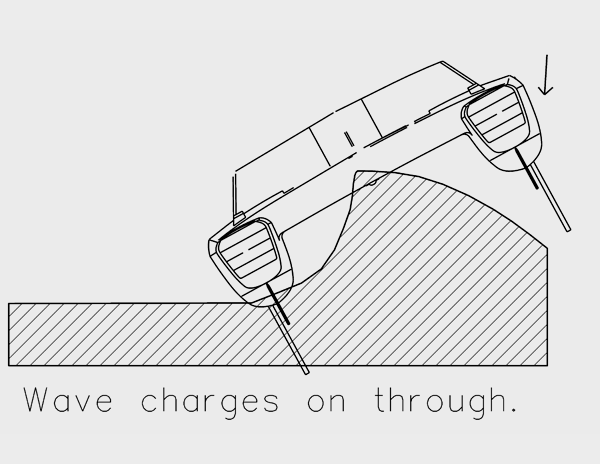
The wave hitting the second hull slams the first one back down and moves on. The wide cat remains flat on the water.
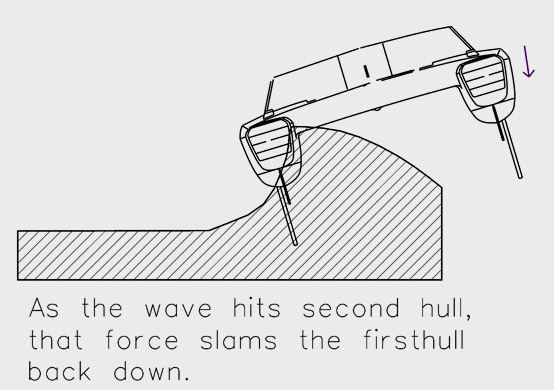
As far as I know, Lock did not study very narrow cats. As I often say, I can tell you what works. I can’t always tell you how bad something done wrong will be. So a wave hits a narrow cat beam on.
Ok that same size wave looks unfair to compare to. Lets give it a wave 25% smaller so it looks more fair. OK, smaller wave. But the first hull keeps going up.
I have a theory that the relevant factors are first, a relationship between wave height and center to center of hulls. Of course a small distance between hulls will cause a cat to get rolled in smaller waves.
I also see a critical relationship between wave speed and distance between hulls.
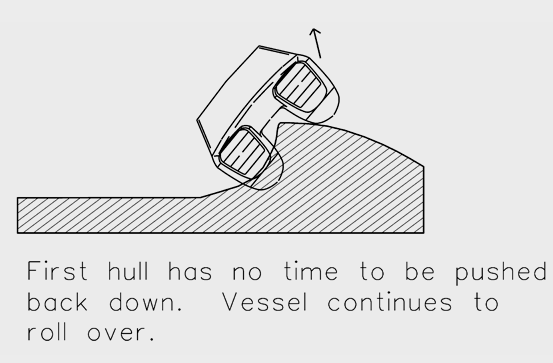
My theory is that with the narrow cats, the first hull never gets a chance to start to fall back down again. The wave it trapped between them as the first hull is still going up.
This could be a very useful thesis study for some student. I recall that Lock found that trimarans of the day behaved like the narrow cat above.
I believe it would have been smarter for the USCG to ask if any of us knew anything about this topic before going thug on us to help them generate a ream of useless data.
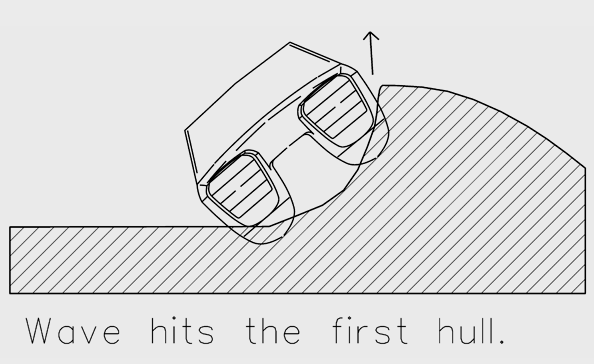
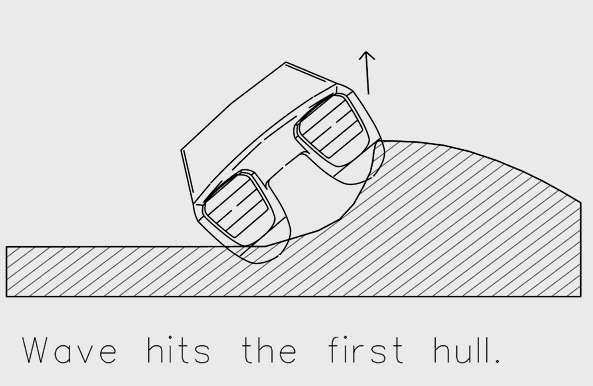
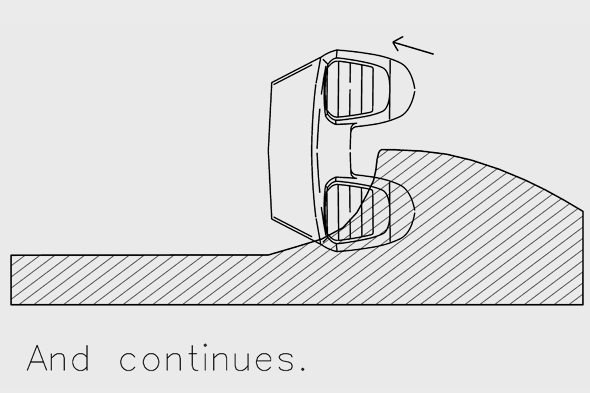
an interesting article…with data!
I’m betting the difference illustrated between wide and narrow beam boats here would vary dramatically with the height of the wave. There is probably a magic ratio of wave height (trough-to-crest) to beam width that determines what the max height of wave is before rollover risk reaches 100%. And I’m betting that a 25′ wave with a nice, steep face will treat a 25′ beam width multi-hull much the same as the narrow-beam one shown with a smaller wave. Clearly it would be in the best interest of the boat owner/operator to know just what that threshold looks like though…
Leave a reply has disappeared from
http://multihullblog.com/2012/01/new-75-trimaran-design/comment-page-1/#comment-73309
Page has some html writings with a unrelated link exposed. Page not written correctly or hacked?
Does not look professional.
thanks, finally got a chance to look at and clean.
Kurt,
One thing more for the USCG’s maw. There is also the lateral movement of the sea water in the trough as the wave approaches; water molecules in the trough are put in motion *towards* the front of the wave. On the wide cat this will have trivial effect as the motion is only slight until right before the high slope of the wave face. With the narrow cat, this motion is moving the lee hull *into* the face of the wave while the boat is still being tipped to leeward by the face of the wave. So it is accelerating the rotation which leads to the capsize.
Marchaj has some detailed information on this in either “Seaworthiness” or “Aerohydrodynamics” (I forget which one) and gives as an example a well-known large monohull that was knocked down to considerable damage in a surprisingly small beam wave. As Richard and you have already said, it isn’t a statics problem; it’s a dynamics problem.
Again if I recall correctly, a few decades ago there was an official report on a certain UK monohull diesel fishing boat design where this effect was a factor. In earlier times the boats were usually v-bottomed, but to get more capacity the new boats were flat-bottomed, moving more of the displacement out to the chines. These boats capsized in beam seas much more readily than the older type, and there was over the course of a few years considerable loss of life. Perhaps an inquiry to some of your UK contacts might dredge up this report.
thanks
There is an overview by Wolfson http://www.wumtia.soton.ac.uk/sites/default/files/1779merged.pdf The Wolfson site needs to be searched carefully as some of the data is ongoing.
thanks
I think you can find that Wolfson study online,…but I don’t recall where at the moment. I also recall Lock’s findings that the catamaran hull form was one of the best to resist large beam-on wave induced capsize,..including the monohull forms.
Sorry I’ve been away from discussions of boating for about 6 months now.
thanks Brian
Kurt,
In the mid-eighties I started building a 40 ft fishing cat for use on the Flemish Banks, a nasty part of the North Sea with fast running tides and weather that changes quickly. So it stands to reason that I had my guys design a wide beam cat, right? Well, the Belgian Coast Guard declined to certify the design because it failed stability tests (designed for single hull vessels of course). Long story short, I got DNV involved and we ended up with a compromise, not as wide as I wanted it, but plenty wide and stable. 25 years later, Jonas is still fishing the same waters: http://www.marinetraffic.com/ais/shipdetails.aspx?MMSI=205311000. OK, she doesn’t look as pretty as when I built her, but she’s still going strong.
Reviewing my notes of dealing with USCG in the late 80s and early 90s makes me crazy.
Remember vaguely an article in one of the early AYRS publications where Dr.Hugo Meyers and a russian Professor did the math for catamaran stability in waves. As I remember they found out that the catamaran is safer than a trimaran (of the old designs). Might be the math will be of some help for your question. Regards, Manfred
Thanks Manfred.
you are right of course.
I saw the video Lock had made by the Wolfson Unit at Southampton University, and the evidence was very clear that catamarans behave as you drew.
In our ISO stability work for the RCD we always assume that a boat in waves is stable until the wave height exceed the beam of the boat, irrespective of the number of hulls
As they say “if you can, do, if you cannot, legislate”
Richard Woods
Richard,
Thank you.
I’m not an expert, just a geek, so this is not authoritative. From looking at the drawings, I would suspect the inertia of the rig and the air that was dragged along to have moved the center of gravity outside of the support of the hulls. In other words, I think the wave just aggravated the situation of the COG being too high for the width of the boat.
Or maybe I misread what you said and have just rephrased it.
George,
Thank you very much for all the information. My completely unscientific sense is that having some time between the two hulls being hit is important. That second or two will allow the first hull to start down before the second is hit. My sense is that if the two hulls are hit at nearly the same time, the first one might be still going up and the rapid second hit could exacerbate that. Just riffing until the tank testing on that one is done or found.